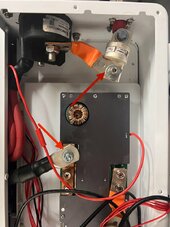So I’m added a Class T fuse to my battery. Made sure the master switch was off of my monster 600V power switch. And as I was tightening the bolts, my knuckle touched the negative wire and I got a minor zap. 
 . So I stopped what I was doing, brought out my volt meter and sure enough there were 53.62 volts on both sides of the switch!! What the heck! Double check the switch for the obvious off position. Checked again in both the on and off switch. Exact voltage!!! First reaction was that I had a bad switch. Then the light bulb went on. I have 2 batteries and they are both plugged into a buss bar. Voltage was flowing in from the other battery.. Smacks head!!!
. So I stopped what I was doing, brought out my volt meter and sure enough there were 53.62 volts on both sides of the switch!! What the heck! Double check the switch for the obvious off position. Checked again in both the on and off switch. Exact voltage!!! First reaction was that I had a bad switch. Then the light bulb went on. I have 2 batteries and they are both plugged into a buss bar. Voltage was flowing in from the other battery.. Smacks head!!!
You are using an out of date browser. It may not display this or other websites correctly.
You should upgrade or use an alternative browser.
You should upgrade or use an alternative browser.
Why was I getting shocked??
- Thread starter wsaharem
- Start date
Nobodybusiness
Collecting the leftovers of the Great Sky Reactor.
Yup that will do it.So I’m added a Class T fuse to my battery. Made sure the master switch was off of my monster 600V power switch. And as I was tightening the bolts, my knuckle touched the negative wire and I got a minor zap.. So I stopped what I was doing, brought out my volt meter and sure enough there were 53.62 volts on both sides of the switch!! What the heck! Double check the switch for the obvious off position. Checked again in both the on and off switch. Exact voltage!!! First reaction was that I had a bad switch. Then the light bulb went on. I have 2 batteries and they are both plugged into a buss bar. Voltage was flowing in from the other battery.. Smacks head!!!
HarryN
Solar Enthusiast
Thanks for writing it up.
I like to put a breaker in between each battery pack and the bus bar.
This makes it easier to:
- Diagnose what is going on
- Shut it down in sections in case something is not quite right
- Re-set the BMS of that battery pack ( which often is done by completely isolating that battery pack )
I like to put a breaker in between each battery pack and the bus bar.
This makes it easier to:
- Diagnose what is going on
- Shut it down in sections in case something is not quite right
- Re-set the BMS of that battery pack ( which often is done by completely isolating that battery pack )
featherlite
Solar Enthusiast
Do you plan on mounting the T fuse in a holder made for that purpose?
No, see the picture where it’s mounted between the switch and the outbound cable connector.Do you plan on mounting the T fuse in a holder made for that purpose?
corn18
Village Idiot
- Joined
- Sep 9, 2021
- Messages
- 767
That notch you cut is a nice touch.No, see the picture where it’s mounted between the switch and the outbound cable connector.
robbob2112
Doing more research, mosty harmless
So,
If you are using a switch to turn on and off a voltage source and the other poll is always conncted - this is typical - When the switch it off you will always read voltage. When you close the switch it will read zero volts.
Class T fuses feel very tight and structural. But they aren't meant to handle any physical load or torque. In your case you might get away with it so long as the bus bar you are connected to can't possibly reach any part of the case or other things to short out on.
Most of the time fuses just blow with a Pfft. But if you have high current from a dead short they can blow violently with a lot of force.
If you are using a switch to turn on and off a voltage source and the other poll is always conncted - this is typical - When the switch it off you will always read voltage. When you close the switch it will read zero volts.
No, see the picture where it’s mounted between the switch and the outbound cable connector.
Class T fuses feel very tight and structural. But they aren't meant to handle any physical load or torque. In your case you might get away with it so long as the bus bar you are connected to can't possibly reach any part of the case or other things to short out on.
Most of the time fuses just blow with a Pfft. But if you have high current from a dead short they can blow violently with a lot of force.
Yep, I don’t mind getting a little zap with 110 every now and then, but not wanting to play with the big amps these batteries can draw. Lots of tape on the exposed ends now. Couldn’t figure out how to get shrink wrap around the corner.So,
If you are using a switch to turn on and off a voltage source and the other poll is always conncted - this is typical - When the switch it off you will always read voltage. When you close the switch it will read zero volts.
Class T fuses feel very tight and structural. But they aren't meant to handle any physical load or torque. In your case you might get away with it so long as the bus bar you are connected to can't possibly reach any part of the case or other things to short out on.
Most of the time fuses just blow with a Pfft. But if you have high current from a dead short they can blow violently with a lot of force.
robbob2112
Doing more research, mosty harmless
Yep, I don’t mind getting a little zap with 110 every now and then, but not wanting to play with the big amps these batteries can draw. Lots of tape on the exposed ends now. Couldn’t figure out how to get shrink wrap around the corner.
Rubber pressure tape - Get the 3M or other that lists it as electrical tape - they also sell a similar product for sealing water leaks on the fly that may or may not insulate (don't ask how I know this, but it involved 240vac).
Just wrap the end of the fuse and bolt. If you ever need to take it off it cuts with a blade. Of course I dunno how you would check the torque on the bolt without remove and replace.
Does anyone ever use locktight on these bolts or does it just not work?
It also comes in red color from other makers used on connections under water like well pumps. Extremely hard to get off only way is slit it and peel it. Think it stated …. food safe on another brand. The military comes up with good stuff.Rubber pressure tape - Get the 3M or other that lists it as electrical tape - they also sell a similar product for sealing water leaks on the fly that may or may not insulate (don't ask how I know this, but it involved 240vac).
Just wrap the end of the fuse and bolt. If you ever need to take it off it cuts with a blade. Of course I dunno how you would check the torque on the bolt without remove and replace.
Does anyone ever use locktight on these bolts or does it just not work?


Old way was varnish cambric tape first and followed by 3m electrical tape which was the only tape certified for a while. 3m black electrical tape is usually good for 600v but not high voltage without cambric. How many rolls would ppl like?
We still had procedures to put black over the red. The regular 3m electrical black tape is easy to get holes that let the lightning out at high voltage. 600v - under is low voltage.
That black tape is lot cheaper then 3m’s old red tape.
What do line men use?
Similar threads
- Replies
- 16
- Views
- 587
- Replies
- 297
- Views
- 11K
- Replies
- 20
- Views
- 878
- Replies
- 2
- Views
- 215



